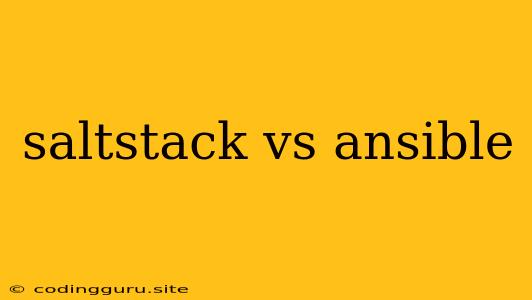SaltStack vs Ansible: Which One is Right for Your Needs?
In the realm of infrastructure management, automation plays a crucial role in streamlining operations and ensuring consistency across diverse environments. Two prominent players in this field, SaltStack and Ansible, have emerged as powerful tools for automating tasks and managing infrastructure at scale. While both offer compelling features, they approach automation from distinct perspectives, making the choice between them a critical one for organizations.
So, how do you determine which tool best aligns with your requirements? To answer this question, let's delve into a comparative analysis of SaltStack and Ansible, exploring their strengths, weaknesses, and key differentiators.
Key Differences: A Glimpse into Their Approaches
SaltStack, often referred to as a "configuration management system," emphasizes a master-minion architecture. This approach involves a central server (the master) managing numerous remote nodes (the minions). SaltStack excels in its ability to manage large-scale deployments, leveraging its distributed architecture and event-driven capabilities.
Ansible, on the other hand, adopts an agentless architecture, requiring no software installation on managed nodes. It relies on SSH for communication and leverages YAML-based playbooks to define automation tasks. This agentless approach simplifies deployment and integration, making Ansible a popular choice for smaller deployments and rapid prototyping.
SaltStack: Diving Deeper
SaltStack stands out as a robust solution for large-scale deployments, particularly in environments with strict security and compliance requirements. Its key features include:
- Master-Minion Architecture: This architecture allows centralized control and management of remote nodes, enhancing security and simplifying troubleshooting.
- Event-Driven Automation: SaltStack's event-driven capabilities enable proactive responses to infrastructure changes, triggering predefined actions based on specific events.
- Infrastructure as Code (IaC): SaltStack embraces IaC principles, allowing infrastructure configuration to be defined and managed using code, promoting consistency and repeatability.
- Zero Trust Security: SaltStack prioritizes security by enforcing a zero-trust model, where all communication is authenticated and encrypted, ensuring data integrity.
- Extensible Architecture: SaltStack's open-source nature and extensive API enable customization and integration with various tools and systems.
Ansible: A Closer Look
Ansible shines in its simplicity and ease of use, making it a popular choice for DevOps teams and individuals with limited automation experience. Its key advantages include:
- Agentless Architecture: Ansible eliminates the need for agents on managed nodes, simplifying deployment and reducing overhead.
- YAML Playbooks: Playbooks define automation tasks using a human-readable YAML format, making them easy to write and maintain.
- Idempotence: Ansible playbooks are idempotent, ensuring that repeated execution produces the same outcome, eliminating potential configuration inconsistencies.
- Community Support: Ansible boasts a large and active community, providing abundant resources, documentation, and support.
- Multi-Platform Support: Ansible supports a wide range of operating systems, cloud platforms, and network devices, expanding its applicability across diverse environments.
Comparing the Two: Making the Right Choice
The choice between SaltStack and Ansible hinges on your specific requirements and the scale of your infrastructure. Here's a breakdown of key considerations:
For Large-Scale Deployments and Complex Infrastructure:
- SaltStack: Offers robust scalability, centralized control, and event-driven capabilities, making it well-suited for large-scale deployments and complex environments.
- Ansible: Might face challenges in managing vast deployments, especially when dealing with intricate infrastructure configurations.
For Smaller Deployments and Rapid Prototyping:
- SaltStack: May introduce complexity and overhead for smaller projects due to its master-minion architecture.
- Ansible: Simplifies deployment and integration, enabling quick prototyping and automation for smaller-scale deployments.
For Security-Sensitive Environments:
- SaltStack: Emphasizes security with its zero-trust model and robust authentication mechanisms.
- Ansible: While secure, its agentless nature may present security considerations in certain environments.
For DevOps Teams with Limited Automation Experience:
- SaltStack: Requires a steeper learning curve due to its complex architecture and features.
- Ansible: Offers a user-friendly interface, simplified syntax, and ample community support, making it easier to learn and use.
In conclusion, the choice between SaltStack and Ansible depends on factors such as deployment scale, security needs, automation complexity, and team experience. SaltStack shines for its scalability, security, and event-driven capabilities, while Ansible excels in its simplicity, ease of use, and extensive community support. By carefully evaluating your specific requirements, you can select the automation tool that best aligns with your needs and facilitates efficient infrastructure management.
